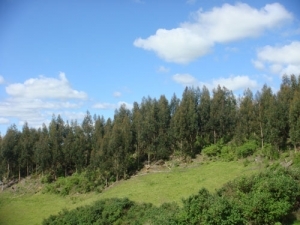Wired for Science: Understanding the feeding habits of mealybug
Fussy children might be frustrating, but fussy mealybugs could help protect the New Zealand wine industry from grapevine leafroll-associated virus 3.
 Dr Wendy McWilliam says the Government and the dairy industry need to work closely together to develop and maintain a landscape-scaled woody vegetation network on both private and public land.
Dr Wendy McWilliam says the Government and the dairy industry need to work closely together to develop and maintain a landscape-scaled woody vegetation network on both private and public land.
The cost and benefits of planting trees to help mitigate environmental effects of dairy farming need to be shared by us all for it to succeed, a new study says.
Evaluation of an agri-environmental program for developing woody green infrastructure within pastoral dairy landscapes: A New Zealand case study says Government incentive programmes are ineffective in overcoming barriers to planting such as the higher cost and slow growth of native plants, and the perception of planting being of little direct benefit to farmers' operations.
Lead author, Lincoln University landscape ecology senior lecturer, Dr Wendy McWilliam, says the Government and the dairy industry need to work closely together to develop and maintain a landscape-scaled woody vegetation network on both private and public land.
Such networks would build sustainability and resilience into New Zealand dairy farming and lead to a more equitable sharing of the benefits and costs of their, primarily, public ecosystem services.
The study's results show few farmers take advantage of Government incentive programmes, largely because they don't cover enough of the costs.
Many farmers are increasing woody vegetation, particularly around waterways and wetlands, to provide public ecosystem services, such as water cleansing and nature conservation. However, many are also removing or replanting their shelterbelts and hedges.
In addition, a significant number of farmers are not planting due to a perceived lack of sufficient private ecosystem services— the benefits the woody vegetation provides to farmers and their farm operations.
The study states a targeted environmental stewardship scheme, including more Government funding, is required to overcome the "considerable barriers to the voluntary retention and restoration of woody vegetation."
The study found plantings are small, limited to unproductive areas, and many continue to be dominated by exotics and monocultures, even though natives, broadleaf, and mixed species plantings are preferred.
Aesthetic services (or enhancing the look of the farm), as well as speed and ease of growth, maintenance, and low costs are significant factors in plant selection.
Key barriers include insufficient private ecosystem services of woody vegetation, particularly those related to dairy production, relative to other land uses; poor aesthetic services of some plantings; and low rates of growth and higher maintenance and purchasing costs of native plants.
McWilliam says farmers may also be motivated by stronger evidence in support of valued ecosystem services, their benefits and drawbacks, and information on how to support ecosystem services through planting design and management through time.
The National Wild Goat Hunting Competition has removed 33,418 wild goats over the past three years.
New Zealand needs a new healthcare model to address rising rates of obesity in rural communities, with the current system leaving many patients unable to access effective treatment or long-term support, warn GPs.
Southland farmers are being urged to put safety first, following a spike in tip offs about risky handling of wind-damaged trees
Third-generation Ashburton dairy farmers TJ and Mark Stewart are no strangers to adapting and evolving.
When American retail giant Cosco came to audit Open Country Dairy’s new butter plant at the Waharoa site and give the green light to supply their American stores, they allowed themselves a week for the exercise.
Fonterra chair Peter McBride says the divestment of Mainland Group is their last significant asset sale and signals the end of structural changes.
President Donald Trump’s decision to impose tariffs on imports into the US is doing good things for global trade, according…
Seen a giant cheese roll rolling along Southland’s roads?